 W
WThe 1922 Turin massacre refers to the attack by Italian Fascists against members of a local labour movement in Turin, Italy, during a three-day terror campaign from 18 to 20 December 1922, to break the resistance of the labour movement and working class to Fascism.
 W
WThe 6 October 1976 massacre, or the 6 October event as it is known in Thailand, was a violent crackdown by Thai police and lynching by right-wing paramilitaries and bystanders against leftist protesters who had occupied Bangkok's Thammasat University and the adjacent Sanam Luang, on 6 October 1976. Prior to the massacre, thousands of leftists – students, workers and others had been holding ongoing demonstrations against the return of former dictator Thanom Kittikachorn to Thailand since mid-September. Official reports state that 46 were killed and 167 were wounded, while unofficial reports state that more than 100 demonstrators were killed. The "Documentation of Oct 6" project, Thongchai Winichakul argued that official death toll should be 45, 40 demonstrators, 5 perpetrators because one demonstrator died in jail after the incident.
 W
WThe Afghan mujahideen were various armed Islamist rebel groups that fought against the government of the Democratic Republic of Afghanistan and the Soviet Union during the Soviet–Afghan War and the subsequent First Afghan Civil War. The term mujahideen is used in a religious context by Muslims to refer those engaged in a struggle of any nature for the sake of Islam, commonly referred to as jihad (جهاد). The Afghan mujahideen consisted of numerous groups that differed from each other across ethnic and/or ideological lines, but were united by their anti-communist and pro-Islamic goals. The union was also widely referred to by their Western backers as the Afghan resistance, while Western press often referred to them as Muslim rebels, guerrillas, or "Mountain Men". They were popularly referred to by Soviet troops as dukhi as derivation from Dari word دشمان dushman, which turned into short dukh and also was suitable due to their guerrilla tactics; Afghan civilians often referred to them as the tanzim, while the Afghan government called them dushman, a term also employed by the Soviets.
 W
WAgent Orange is a herbicide and defoliant chemical, one of the "tactical use" Rainbow Herbicides. It is widely known for its use by the U.S. military as part of its herbicidal warfare program, Operation Ranch Hand, during the Vietnam War from 1961 to 1971. It is a mixture of equal parts of two herbicides, 2,4,5-T and 2,4-D. In addition to its damaging environmental effects, traces of dioxin found in the mixture have caused major health problems for many individuals who were exposed, and their offspring.
 W
WThe Alianza Americana Anticomunista was a paramilitary far-right group mainly operating in Colombia between 1978 and 1979.
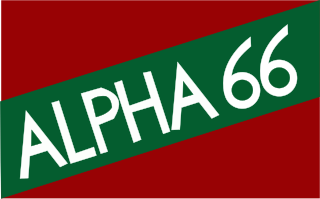 W
WAlpha 66 is an anti-Castro paramilitary organization that operates in the Southern United States. The group was originally formed by Cuban exiles in the early 1960s and was most active in the late 1970s and 1980s. Although its base of support has greatly eroded due to the end of the Cold War and the thawing of relations between the United States and Cuba, Alpha 66 is still active today and is recognized as a terrorist organization by state governments and research groups alike.
 W
WOn 12 October 1960, Inejirō Asanuma , chairman of the Japan Socialist Party, was assassinated at Hibiya Public Hall in Tokyo. During a televised debate, a 17-year-old right-wing ultranationalist named Otoya Yamaguchi charged onto the stage and fatally stabbed Asanuma with a wakizashi.
 W
WThe Caravan of Death was a Chilean Army death squad that, following the Chilean coup of 1973, flew by helicopters from south to north of Chile between September 30 and October 22, 1973. During this foray, members of the squad ordered or personally carried out the execution of at least 75 individuals held in Army custody in certain garrisons. According to the NGO Memoria y Justicia, the squad killed 97 people: 26 in the South and 71 in the North. Augusto Pinochet was indicted in December 2002 in this case, but he died four years later without having been judged. His trial, however, is ongoing since his and other military personnel and a former military chaplain have also been indicted in this case.
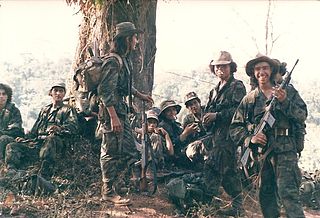 W
WCIA activities in Nicaragua have been ongoing since the 1980s. The increasing influence gained by the Sandinista National Liberation Front, a left-wing and anti-imperialist political party in Nicaragua, led to a sharp decrease in Nicaragua–United States relations, particularly after the Nicaraguan Revolution. In 1981, President Ronald Reagan authorized the Central Intelligence Agency to support the Contras, a right-wing Nicaraguan political group to combat the influence held by the Sandinistas in the Nicaraguan government. Various anti-government rebels in Nicaragua were organized into the Nicaraguan Democratic Force, the first Contra group, at the behest of the CIA. The CIA also supplied the Contras with training and equipment, including materials related to torture and assassination. There have also been allegations that the CIA engaged in drug trafficking in Nicaragua.
 W
WThe Colombian conflict began on May 27, 1964, and is a low-intensity asymmetric war between the government of Colombia, far-right paramilitary groups, crime syndicates, and far-left guerrilla groups such as the Revolutionary Armed Forces of Colombia (FARC), the National Liberation Army (ELN) and the Popular Liberation Army (EPL), fighting each other to increase their influence in Colombian territory. Some of the most important international contributors to the Colombian conflict include multinational corporations, the United States, Cuba, and the drug trafficking industry.
 W
WThe Contras were the various U.S.-backed and funded right-wing rebel groups that were active from 1979 to the early 1990s in opposition to the Marxist Sandinista Junta of National Reconstruction Government in Nicaragua which came to power in 1979 following the Nicaraguan Revolution. Among the separate contra groups, the Nicaraguan Democratic Force (FDN) emerged as the largest by far. In 1987, virtually all contra organizations were united, at least nominally, into the Nicaraguan Resistance.
 W
WCubana de Aviación Flight 455 was a Cuban flight from Barbados to Jamaica that was brought down on 6 October 1976 by a terrorist bomb attack. All 73 people on board the Douglas DC-8 aircraft were killed after two time bombs went off and the plane crashed into the sea. The crash killed every member of the Cuban national fencing team.
 W
WThe Dirty War is the name used by the military junta or civic-military dictatorship of Argentina for the period of state terrorism in Argentina from 1976 to 1983 as a part of Operation Condor, during which military and security forces and right-wing death squads in the form of the Argentine Anticommunist Alliance hunted down any political dissidents and anyone believed to be associated with socialism, left-wing Peronism, or the Montoneros movement.
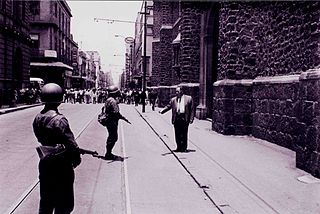 W
WThe Mexican Dirty War refers to the Mexican theater of the Cold War, an internal conflict in the 1960s and 1980s between the Mexican PRI-ruled government under the presidencies of Gustavo Díaz Ordaz, Luis Echeverría and José López Portillo, which were backed by the US government, and left-wing student and guerrilla groups. During the war, government forces carried out disappearances, estimated at 1,200, systematic torture, and "probable extrajudicial executions".
 W
WThe East Turkestan Liberation Organization (ETLO) was a secessionist Uyghur organization that advocated for an independent Uyghur state named East Turkestan in the Western Chinese province known as Xinjiang. The organization was established in Turkey in 1990 or 1996 to fight against the Chinese government in Xinjiang, a territory of ethnic Uyghur majority. ETLO is a designated terrorist organization by the governments of China, Kazakhstan, and Kyrgyzstan.
 W
WThe Fatherland and Liberty Nationalist Front was a fascist political and paramilitary group that fought against the democratically elected socialist government of Salvador Allende, in Chile.
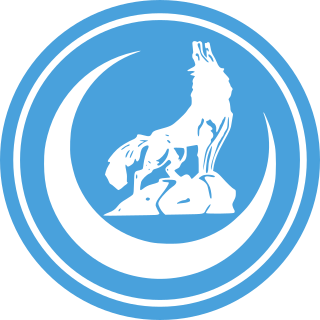 W
WThe Grey Wolves, officially known as Idealist Hearths, is a Turkish far-right organization and movement affiliated with the Nationalist Movement Party (MHP). Commonly described as ultranationalistic, Islamistic and neo-fascist, it is a youth organization that has been characterized as MHP's paramilitary or militant wing. Its members deny its political nature and claim it to be a cultural and educational foundation, as per its full official name: Ülkü Ocakları Eğitim ve Kültür Vakfı.
 W
WThe Indonesian mass killings of 1965–66, also known as the Indonesian genocide, Indonesian Communist Purge, or Indonesian politicide, were large-scale killings and civil unrest that occurred in Indonesia over several months, targeting Communist Party of Indonesia (PKI) party members, communist sympathisers, Gerwani women, ethnic Javanese Abangan, ethnic Chinese, and alleged leftists, often at the instigation of the armed forces and government, which were supported by the United States and other Western countries. It began as an anti-communist purge following a controversial attempted coup d'état by the 30 September Movement. The most widely published estimates were that 500,000 to more than one million people were killed, with some more recent estimates going as high as two to three million. The purge was a pivotal event in the transition to the "New Order" and the elimination of PKI as a political force, with impacts on the global Cold War. The upheavals led to the fall of President Sukarno and the commencement of Suharto's three-decade authoritarian presidency.
 W
WThe Jeju uprising, known in South Korea as the Jeju April 3 incident, was an uprising that occurred on Jeju Island from April 1948 to May 1949. Residents of Jeju opposed to the division of Korea had protested and had been on a general strike since 1947 against elections scheduled by the United Nations Temporary Commission on Korea (UNTCOK) to be held only in the territory controlled by the United States Army Military Government in Korea. The Workers' Party of South Korea and its supporters launched an insurgency in April 1948, attacking the police, and Northwest Youth League members stationed on Jeju mobilized to violently suppress the protests. The First Republic of Korea under President Syngman Rhee escalated the suppression of the uprising from August 1948, declaring martial law in November and beginning an "eradication campaign" against rebel forces in the rural areas of Jeju in March 1949, defeating them within two months. Many rebel veterans and suspected sympathizers were later killed upon the outbreak of the Korean War in June 1950, and the existence of the Jeju uprising was officially censored and repressed in South Korea for several decades.
 W
WThe Kashmir Princess was a chartered Lockheed L-749A Constellation aircraft owned by Air India. On 11 April 1955, it was damaged in midair by a bomb explosion and crashed into the South China Sea while en route from Bombay, India, and Hong Kong to Jakarta, Indonesia. Sixteen of those on board were killed, while three survived. The explosion was an assassination attempt targeting Chinese Premier Zhou Enlai, who missed the flight due to a medical emergency and was not on board. The Chinese government concluded that the Kuomintang (KMT) were responsible for the bombing.
Kim Du-han, also spelled Kim Doo-han, was a South Korean mobster, anti-communist activist, politician and the son of Kim Chwa-chin. His ho / pen name was Uisong. He was notorious for right-wing terrorism against communists or pro-North Korean left-wing peoples, but showed complex tendencies, such as sympathizing with Democratic liberalism and democratic socialism.
 W
WAlfonso López Trujillo was a Colombian Cardinal Bishop of the Roman Catholic Church and president of the Pontifical Council for the Family.
 W
WThe Mustafa Band was a group of four Albanian exiles who wanted to kill Enver Hoxha in 1982. The plan failed and two of its members were killed and one arrested.
 W
WThe Mỹ Lai massacre was the mass murder of unarmed South Vietnamese civilians by U.S. troops in Sơn Tịnh District, South Vietnam, on 16 March 1968 during the Vietnam War. Between 347 and 504 unarmed people were killed by U.S. Army soldiers from Company C, 1st Battalion, 20th Infantry Regiment and Company B, 4th Battalion, 3rd Infantry Regiment, 11th Brigade, 23rd (Americal) Infantry Division. Victims included men, women, children, and infants. Some of the women were gang-raped and their bodies mutilated, as were children as young as 12. Twenty-six soldiers were charged with criminal offenses, but only Lieutenant William Calley Jr., a platoon leader in C Company, was convicted. Found guilty of killing 22 villagers, he was originally given a life sentence, but served three-and-a-half years under house arrest.
 W
WThe Northwest Youth League was a South Korean right-wing paramilitary group that carried out anti-communist terrorism during the Cold War. Most infamously, the group massacred thousands of people in the Jeju Uprising.
 W
WOperation Condor was a United States-backed campaign of political repression and state terror involving intelligence operations and assassination of opponents. It was officially and formally implemented in November 1975 by the right-wing dictatorships of the Southern Cone of South America.
 W
WThe Peruvian prison massacres occurred on June 18–19, 1986, after a series of riots in the San Pedro, Santa Mónica, and El Frontón prisons in Lima and Callao. The military repression of these riots resulted in the loss of at least 224 lives.
 W
WThe Phoenix Program was a program designed and coordinated by the United States Central Intelligence Agency (CIA) during the Vietnam War, involving the American, Australian and South Vietnamese militaries.
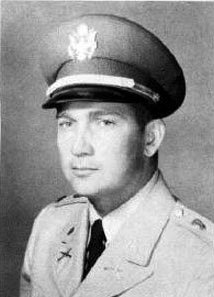 W
WLuis Clemente Posada Carriles was a Cuban exile militant and Central Intelligence Agency (CIA) agent. He was considered a terrorist by the United States' Federal Bureau of Investigation (FBI) and the Government of Cuba, among others.
 W
WAl-Qaeda is a militant Sunni Islamist multinational network of Islamic extremists and Salafist jihadists. It was founded in 1988 by Osama bin Laden, Abdullah Azzam, and several other Arab volunteers during the Soviet–Afghan War.
 W
WJosé Efraín Ríos Montt was a Guatemalan military officer and politician who served as de facto President of Guatemala in 1982-83. His brief tenure as chief executive was one of the bloodiest periods in the long-running Guatemalan Civil War. Ríos Montt's counter-insurgency strategies significantly weakened the leftist Guatemalan National Revolutionary Unity (URNG) guerrilla, while also leading to accusations of war crimes and genocide perpetrated by the Guatemalan Army under his leadership.
 W
WSalwa Judum was a militia that was mobilised and deployed as part of anti-insurgency operations in Chhattisgarh, India, aimed at countering Naxalite violence in the region. The militia, consisting of local tribal youth, received support and training from the Chhattisgarh state government. It has been outlawed and banned by a Supreme Court court order, but continues to exist in the form of Armed Auxiliary Forces, District Reserve Group and other vigilante groups.
 W
WThe Shanghai massacre of 12 April 1927, the April 12 Purge or the April 12 Incident as it is commonly known in China, was the violent suppression of Chinese Communist Party (CCP) organizations and leftist elements in Shanghai by forces supporting General Chiang Kai-shek and conservative factions in the Kuomintang. Following the incident, conservative KMT elements carried out a full-scale purge of Communists in all areas under their control, and violent suppression occurred in Guangzhou and Changsha. The purge led to an open split between left and right wing factions in the KMT, with Chiang Kai-shek establishing himself as the leader of the right wing faction based in Nanjing, in opposition to the original left-wing KMT government based in Wuhan led by Wang Jingwei.
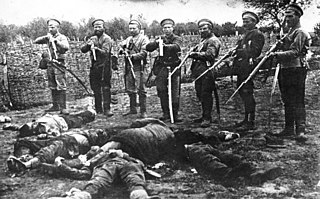 W
WThe White Terror in Russia refers to the organized violence and mass killings carried out by the White Army during the Russian Civil War (1917–23). It began after the Bolsheviks seized power in November 1917, and continued until the defeat of the White Army at the hands of the Red Army. The White Army fought the Red Army for power, which engaged in its own Red Terror. According to some Russian historians, the White Terror was a series of premeditated actions directed by their leaders, although this view is contested. Estimates for those killed in the White Terror vary, from between 20,000 and 100,000 people as well as much higher estimates of 300,000 deaths.
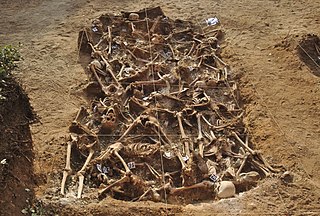 W
WIn the history of Spain, the White Terror describes the political repression, including executions and rapes, which were carried out by the Nationalist faction during the Spanish Civil War (1936–1939), as well as during the first nine years of the regime of General Francisco Franco. In the 1936–1945 period, Francoist Spain had many official enemies: Loyalists to the Second Spanish Republic (1931–1939), Liberals, socialists of different stripes, Protestants, atheists, intellectuals, homosexuals, Freemasons, Jews, Romanis, Basque, Catalan, Andalusian and Galician nationalists.